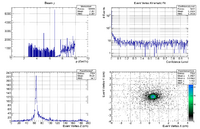Difference between revisions of "December 3, 2014 Calibration"
(→Agenda) |
(→FCAL) |
||
| Line 50: | Line 50: | ||
=== FCAL === | === FCAL === | ||
| + | |||
| + | * Matt reviewed the current status of the FCAL energy scale. The base energy scale in the CCDB was increased by a factor 4. A factor 2 of this is due to an increase in the high voltage setting which hadn't been applied to the reconstruction. Another factor 2 was determined by using electrons hitting the inner rings of the FCAL. The other factor of two could have been due to several other factors. One is that the previous calibration was estimated only roughly from the FCAL beam test. Another is that the observed pi0's were of low energy, and high DAC thresholds could have been excluding a significant number of cells on the edges of the showers. | ||
| + | * The next step is to do a finer calibration by using the algorithm which balances relative gains between blocks by minimizing the width of the pi0 peak. John Z. has written a plugin to do this, but it is an iterative procedure, so Matt is working on a plugin to skim the pi0-containing events to speed the procedure up. | ||
| + | * Using these improved calibrations, they can determine increased HV settings and lower DAC thresholds to improve efficiency. | ||
| + | * After some discussion with Sasha, the per-block energy threshold was estimated to be ~5 MeV, which was agreed to be on the high side. | ||
| + | |||
| + | === BCAL === | ||
### pi0's/electrons in FCAL - [http://argus.phys.uregina.ca/cgi-bin/private/DocDB/ShowDocument?docid=2609 GlueX-Doc-2609] [http://argus.phys.uregina.ca/cgi-bin/private/DocDB/ShowDocument?docid=2610 GlueX-Doc-2610] | ### pi0's/electrons in FCAL - [http://argus.phys.uregina.ca/cgi-bin/private/DocDB/ShowDocument?docid=2609 GlueX-Doc-2609] [http://argus.phys.uregina.ca/cgi-bin/private/DocDB/ShowDocument?docid=2610 GlueX-Doc-2610] | ||
Revision as of 01:11, 4 December 2014
GlueX Calibration Meeting
Wednesday, December 3, 2014
11:00 am, EDT
JLab: CEBAF Center, F326
Connection Using Bluejeans
- To join via Polycom room system go to the IP Address: 199.48.152.152 (bjn.vc) and enter the meeting ID: 630804895.
- To join via a Web Browser, go to the page [1] https://bluejeans.com/630804895.
- To join via phone, use one of the following numbers and the Conference ID: 630804895
- US or Canada: +1 408 740 7256 or
- US or Canada: +1 888 240 2560
- Upon connection all microphones are automatically muted. To unmute your mike on a Polycom or equivalent unit, enter *4
- More information on connecting to bluejeans is available.
Agenda
- Announcements
- Status Update
- Calibration status/updates
- Calorimetry
- pi0's/electrons in FCAL - GlueX-Doc-2609 GlueX-Doc-2610
- Calibration of BCAL with cosmic data (Andrei & Irina)
- Tracking
- dE/dx measurements (Justin)
- beta v. p measurements
- Paul
- Justin ELOG 3310070
- Vertex Kinematic Fitting - Paul
- TOF / Start Counter
- Calorimetry
- Data Monitoring
- Commissioning Software
- Run Browser, Plot Browser, and Time Series webpages
- Physics Analysis
- ω Peak Hunt: Mike?
- Δ Peak Hunt: Justin?
- ρ Peak Hunt: Sean?
- γ p → p π+ π-: Kei?
- K0 Peak Hunt: Naomi
- AOB
Minutes
Attending: Sean (NU); Simon, Beni, Kei, Nathan, Mark I., Will M., Sasha S., Elton, Will L., David L., Sergey F., Mike S. (JLab); Matt S. (IU); Curtis, Paul, Naomi (CMU); Eric (FIU); Justin (MIT)
Status Update
Activity in the CCDB has been slowing ramping up. Nathan set the tagger endpoint energy to enable the calculation of the photon energies in the tagger. Simon added some preliminary inter-detector time offsets. These depend on the trigger timing. He is going to update these numbers for the FCAL trigger today; numbers for the BCAL trigger will follow after some further analysis. Some run-dependent constants have also been added, including target conditions and FCAL gains.
FCAL
- Matt reviewed the current status of the FCAL energy scale. The base energy scale in the CCDB was increased by a factor 4. A factor 2 of this is due to an increase in the high voltage setting which hadn't been applied to the reconstruction. Another factor 2 was determined by using electrons hitting the inner rings of the FCAL. The other factor of two could have been due to several other factors. One is that the previous calibration was estimated only roughly from the FCAL beam test. Another is that the observed pi0's were of low energy, and high DAC thresholds could have been excluding a significant number of cells on the edges of the showers.
- The next step is to do a finer calibration by using the algorithm which balances relative gains between blocks by minimizing the width of the pi0 peak. John Z. has written a plugin to do this, but it is an iterative procedure, so Matt is working on a plugin to skim the pi0-containing events to speed the procedure up.
- Using these improved calibrations, they can determine increased HV settings and lower DAC thresholds to improve efficiency.
- After some discussion with Sasha, the per-block energy threshold was estimated to be ~5 MeV, which was agreed to be on the high side.
BCAL
- pi0's/electrons in FCAL - GlueX-Doc-2609 GlueX-Doc-2610
- Calibration of BCAL with cosmic data (Andrei & Irina)
- Tracking
- dE/dx measurements (Justin)
- beta v. p measurements
- Paul
- Justin ELOG 3310070
- Vertex Kinematic Fitting - Paul
- TOF / Start Counter
- Data Monitoring
- Commissioning Software
- Run Browser, Plot Browser, and Time Series webpages
- Physics Analysis
- ω Peak Hunt: Mike?
- Δ Peak Hunt: Justin?
- ρ Peak Hunt: Sean?
- γ p → p π+ π-: Kei?
- K0 Peak Hunt: Naomi
- AOB
